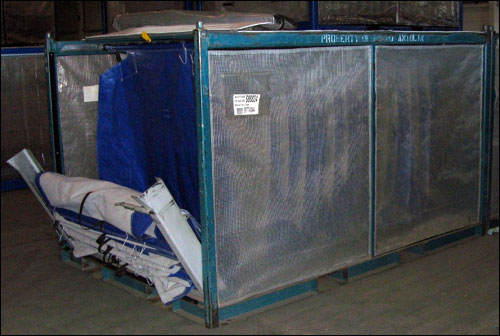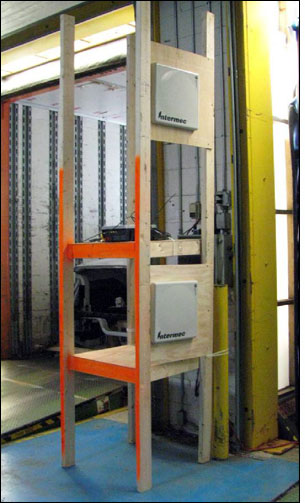The Automotive Industry Action Group (AIAG) reports that a study it recently published proves the feasibility of encoding multiple types of data—that is, a unique item identifier (UII) and user information—on a single RFID tag, thereby enabling numerous players in the automotive supply chain to encode and then utilize the tags for their own purposes.
The study’s findings are significant, says Fangming Gu, a staff researcher in General Motors‘ (GM) Research and Development division, because they indicate that automakers, parts suppliers, and logistics firms would not need to each invest in their own RFID tags to encode and store the data that matters to them. Instead, Gu says, the group found that an EPC Gen 2 tag with between 512 bits and 2 kilobits of user memory could be employed to store a UII, as well as other information, such as the container’s sequence number at the start and end of the transportation, along with the ID number of the trailer in which the container was loaded.
“The big problem for the automotive industry [related to implementing RFID tracking] is the cost is too high for tags,” Gu explains. “Everyone wants their own customized tags,” with data tailored to their needs. The study, he says, is the first to prove that a single tag can be encoded with all data required by the many participants in the supply chain.
Bill Hoffman, the project’s leader, and the founder and managing director of RFID and bar-code software and integration company Hoffman Systems, says the study was inspired by a presentation at the 2005 AIAG AutoTech Conference, indicating that $750 million is lost by the industry annually due to misplaced pallets, boxes, barrels and other reusable containers. “We’ve known about this for quite some time,” he states. “It’s the 500-pound gorilla sitting in the corner.” To maintain greater visibility in the supply chain, which could reduce that expense, the reusable containers need to have identifying labels that are read as they change hands. However, he adds, bar codes offer a limited solution, since new data can not be written to a bar code once it is printed.
The problem with RFID, on the other hand, has been tag cost. Therefore, the researchers began studying how a single tag could serve the various supply chain participants, thereby reducing the number of tags needed for each container.
“Our primary goal was to see if one physical RFID tag could carry two disparate pieces of data,” Hoffman says. Specifically, the project’s participants first programmed an EPCglobal-based serialized Global Returnable Asset Identifier (GRAI) into the tag’s unique item identifier memory bank (UII-MB01), and then subsequently encoded ISO-based data identifier (DI) information to the tag’s user memory bank (MB11), such as a trailer ID number (DI 4B), a product number (DI P), quantity (DI Q) and start/end sequence numbers (DIs 31S/32S).
The study’s intent was also to prove that data from RFID tag reads could be used and analyzed by suppliers, automotive companies and shippers. An end user, for instance, could look up a product’s ID number in their software, link it to a container ID and then ascertain how quickly a particular container was transported, or where it was last read. What’s more, logistics providers could compare information related to the time during which containers were in transit, for example, thereby determining when shipments were delayed by traffic or some other reason.
As a result of the study’s findings, Hoffman reports, the automotive industry participants are interested in implementing RFID to track reusable containers, though no installations are currently underway. In the meantime, AIAG’s Pallet and Lid Committee has been meeting to develop a recommendation for the organization’s B-11 automotive item-level RFID standard (see The Chasm Between RFID Standards and Implementation).
For the study, the group had planned to install temporary RFID interrogators at three facilities: two supplier plants—Grupo Antolin‘s Marlette assembly plant and the company’s Lake Orion Sequencing Center (where the products were placed in the sequence in which they would be shipped and then installed by GM)—and one receiving plant, the GM Lake Orion Assembly Plant. However, due to damage to a tower that had been built to hold an Alien Technology ALR 9900 RFID interrogator at GM’s Orion plant, the Alien reader was instead installed at the exit/entrance to the Lake Orion Sequencing Center, to track containers as they departed for or arrived from the Marlette facility.
A second interrogator—this one from Motorola—was also installed at the Lake Orion Sequencing Center, and was used to read tags on containers being shipped to and from the GM facility, as well as those traveling to and from Grupo Marlette. Rumble Trucking transported the containers. A variety of EPC Gen 2 ultrahigh-frequency (UHF) tags with 512 bits of user memory were used. Each returnable asset had one tag attached to it.
For the first portion of the study, Grupo Antolin’s racks fitted with RFID tags were stacked two-high in a trailer. The racks were read as they left the Marlette facility, and again as they arrived at the Lake Orion site. The tags were encoded with the GRAI and a trailer number, and the product part number and quantity were then linked to the tag ID in the software. Each tag was attached to the container in a pouch that held a printed shipping label. At Grupo Antolin’s Lake Orion site, the tags were encoded with a sequence number, after which they were shipped to GM’s assembly plant.
After the GM plant unloaded the parts, the empty containers were returned to the Lake Orion Sequencing Center, and the tags were read once more. In a real production environment, Gu says, the product data stored in MB11 memory would be erased once the parts within the rack have been unloaded or removed, and they might also be rewritten with new information—such as the ID number of the trailer transporting the empty racks back to the facility. During the research project, however, participants did not update the data on the RFID tag’s MB11 on the empty racks.
Tags used included Alien’s Squiggle and TIE inlays, Starport Technologies‘ Portunus-I and Intermec‘s IT 65. The Alien ALR 9900 interrogator was supplied by Ohio University, Pyramid Solutions provided a Motorola XR450 reader, and Intermec contributed its own IF61 Enterprise reader, installed at Grupo Antolin’s Marlette plant. Ohio University provided software to store and interpret tag data read by the two RFID interrogators at Grupo Antolin’s Orion site. Intermec supplied software to read and filter tag data at the Marlette facility.
The participants also used Intermec’s CN3 and IP30 RFID handheld interrogators to show that a tag’s MB01 and MB11 memory could be read as needed. Additionally, the researchers utilized the handhelds to change MB11 data on a random basis, in order to demonstrate in-service reprogramming capability.
The researchers indicate their study proves that both of the tag’s memory banks (MB01 with EPCglobal-based data, and MB11 with ISO-based data) can be read at very high read rates. All three fixed interrogators read the tags at an observed rate of 100 percent, the group reports. Altogether, 250 racks owned by Grupo Antolin, as well as 50 owned by GM, were tagged and tracked.
Because the readers had approximately a 15-foot read range, Gu says, they often captured stray reads of tags as containers were moved about in the warehouse. Shielding or better antenna placement could have addressed the problem, he notes.




